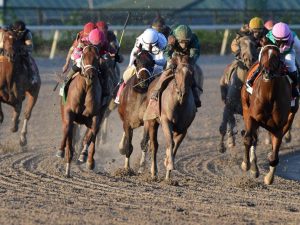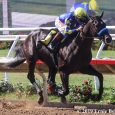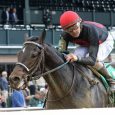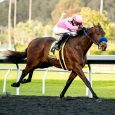By Ray Wallin

Horse Racing – USR Photo
As horseplayers, we like to root for the underdog. We live for upsets since they usually pay better than the 1-5 favorite cruising home for fun. Sometimes even crusty old guys who make their living playing the races find a soft spot for the horse that goes out and keeps trying, even if they never win a race.
We scanned the world to find the biggest losers on the track, the horses that never broke their maiden, but never gave up trying. They may not have had the fame and fortune of the Triple Crown winners, but they grew a cult following.
Vote For Lust (90-0-5-5)
Foaled in 2002 out of Voting and Lust for Spring, this Australian bay gelding retired from racing in 2014. He did manage to win $22,032 in purse money. When he was a 9-year-old he won a competition through Betfair, which was looking to find the country’s worst racehorse to offer a sponsorship. He even ran in two match races on Melbourne Cup days to no avail, but he scored two of his five second-place finishes.
This calm natured gelding ended up being a gift to owner and trainer John Castleman’s granddaughter.
Dona Chepa (135-0-1-2)
This mare raced exclusively in Puerto Rico between 2001 and 2008, amassing a lifetime total of $14,028 running in both claiming and maiden claiming ranks. The brown mare debuted on Valentine’s Day in 2001, finishing last in a field of eight, 35-3/4 lengths from the lead. Her lone second-place finish occurred on May 25, 2003 — 2,021 days before her last race which was a last-place finish against $5,000 claimers where she was beaten 35-1/4 lengths.
Interestingly enough, she had great breeding. Her sire was Stag Dinner, who was out of the 1972 Kentucky Derby winner Riva Ridge and The Bride, who was a full sister to Secretariat.
Zippy Chippy (100-0-8-12)
Arguably the most famous of the biggest losers on the track, this bay gelding captured America’s attention in the late 1990’s and early 2000’s. Owner and trainer Felix Monserrate acquired this famous gelding in 1995 by trading his 1988 Ford truck.
Zippy Chippy even lost a 40-yard dash in 2000 to then minor league outfielder Jose Herrera. Herrera didn’t go on to have a great career either, playing parts of two seasons with the Oakland Athletics in the mid-90’s and two seasons in Korea. Zippy Chippy did beat two other baseball players in a sprint, Darnell McDonald and Larry Bigbie, and a standardbred trotter named Paddy’s Laddy as they hit the wire.
He was banned at most tracks leading up to his finale in 2004 at Northampton Fair, where he went off as the second betting choice at 7-2 yet finished last in his 100th trip to post.
In his retirement, Zippy Chippy remained on the track as on outrider pony at Finger Lakes where he had been banned from racing in 1998 after three consecutive races where he failed to leave the starting gate. After his career as an outrider pony, he was retired to Old Friends Thoroughbred Retirement Farm near Saratoga in 2010.
Meine Attrice (192-0-2-6)
This gray mare sold for 3,675,000 yen (about $35,000) in 2004 before what is arguably the worst racing career in all horse racing. She would go on to win 256,000 yen, or about $2,400 over her eight-year racing career. She would last hit the board in 2008 and would retire in 2012. Her pedigree suggested something different though with Northern Dancer, Nijinsky, and Native Dancer on her dam side.
Haru Urara (113-0-5-7)
Once dubbed as the Japanese “shining start of losers everywhere” this bay mare was as popular in Japan as Zippy Chippy was in America. She was sired by Nippo Teio, who had a solid career on the track and even had some Northern Dancer on that side of her pedigree.
She earned about four times what fellow Japanese runner Meine Attrice would earn over her career. Haru Urara would be a pop culture hit though through merchandising with toys, key rings, hats, books, songs, and movies about her.
Her career spanned seven years from 1998 to 2004.
Quixall Crossett (103-0-2-6)
This bay gelding became the British equivalent of America’s Zippy Chippy and Japan’s Haru Urara. This gutsy veteran debuted in 1990 and tried flats, hurdles, and chases. It was to no avail. His career would end in 2001 as a 16-year-old after losing a race at Wetherby by more than 80 lengths and then unseating his rider in his last two starts, but he did have an adoring fan club.
He was named after the Manchester United striker Albert Quixall who was known more for his off-field exploits than prowess on the field. While not a champion on the track, this gelding helped husband and wife Ted and Joy Caine cope with the loss of their son in a farming accident. Sometimes the therapeutic power of the horse is worth more than the record on the track.
Sadly he had to be euthanized in 2006 at the age of 21.
The Mostly Forgotten Trio
There isn’t much to found about the last three big losers.
Ouroene was winless in 124 tries. Not much can be found on this Australian mare that raced between 1976 and 1983, other than the fact that she died on the track after breaking a leg at the age of 11.
The gelding Thrust was winless in 105 tries during the 1950’s in North America.
Japan’s Gloria Springs was winless in 106 career tries.
Sometimes it’s as hard to lose this many races as it is to actually win one. I doubt that we’ll see any more thoroughbreds eclipse the century mark in the loss column without a win. Animal activists will scream and protest rather than view it as a novelty like we did with Zippy Chippy.
Maybe it’s like my friend Don Tot’s theory on playing pool, if you hit the balls hard enough one will find its way into the pocket. If you enter a horse into enough races, eventually they will win one?




